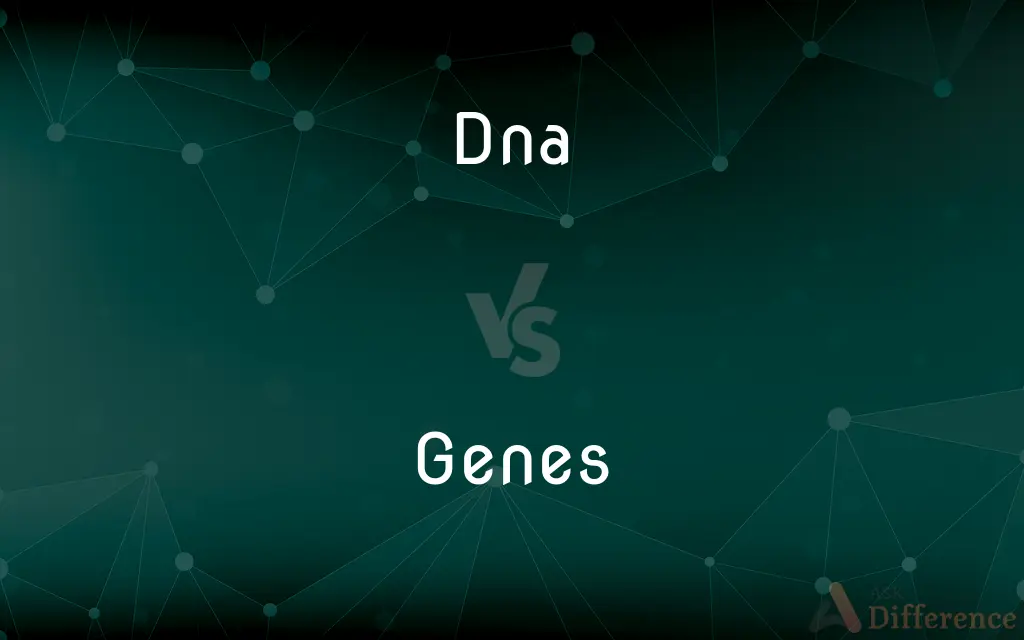DNA vs. Genes — What's the Difference?
By Fiza Rafique & Maham Liaqat — Updated on May 10, 2024
DNA is the molecule that holds the genetic blueprint of an organism, while genes are specific sequences within DNA that code for proteins or functional RNA.

Difference Between DNA and Genes
Table of Contents
ADVERTISEMENT
Key Differences
DNA (deoxyribonucleic acid) is a long molecule that contains the entire genetic instructions necessary for building and maintaining an organism. Whereas genes are segments of DNA that are instructions for producing specific proteins or molecules that have specific functions in the organism.
Every cell in an organism’s body contains the same DNA, but different genes are expressed or turned on in different cells and at different times. In contrast, a gene’s activity can vary based on the cell type, developmental stage, or in response to environmental factors.
DNA is structured as a double helix consisting of a phosphate backbone and nucleotide bases, while a gene consists of a sequence of nucleotides within this structure that provides the template to build a protein.
The study of DNA encompasses understanding the entire genome and how its parts interact and control the organism at a molecular level. On the other hand, genetic research can focus more specifically on individual genes to understand their effects on health and disease.
Mutations can occur in DNA, but when they occur in specific genes, they can lead to changes in the protein that the gene codes for, potentially causing disease or varying traits in the organism.
ADVERTISEMENT
Comparison Chart
Definition
The molecule that carries the genetic blueprint of an organism.
Specific segments of DNA that code for proteins or functional RNA.
Structure
Long double helix made of nucleotide sequences.
Specific sequence of nucleotides within DNA.
Function
Contains all genetic information.
Codes for specific proteins or functions.
Variation
Same throughout an individual’s body.
Expressed variably across different cells and conditions.
Focus of Study
Whole genome and its functionality.
Individual gene functions and their impact on health and traits.
Compare with Definitions
Dna
DNA is the hereditary material in humans and almost all other organisms.
Scientists analyze DNA to determine genetic relationships.
Genes
Genes are units of heredity and are made up of DNA.
Genes pass traits from parents to offspring.
Dna
Changes in DNA can affect the organism’s development and functioning.
Mutations in DNA can lead to genetic disorders.
Genes
Genes are activated or deactivated depending on the needs of the cell.
Certain genes are only active during specific developmental stages.
Dna
DNA is replicated during cell division.
Each new cell receives a copy of DNA during cell division.
Genes
Genes are a focal point in genetic research and therapy.
Gene therapy aims to treat disease by altering genes.
Dna
DNA is composed of two strands forming a double helix.
The double helix structure of DNA was discovered in 1953.
Genes
They specify the synthesis of proteins that lead to various traits and functions.
The gene for eye color determines whether someone has blue or brown eyes.
Dna
It carries all the information required to build and maintain an organism.
Researchers study DNA to understand evolutionary biology.
Genes
Mutations in genes can lead to diseases.
The BRCA gene mutation increases the risk of breast and ovarian cancer.
Dna
Deoxyribonucleic acid, a self-replicating material which is present in nearly all living organisms as the main constituent of chromosomes. It is the carrier of genetic information.
Genes
A hereditary unit consisting of a sequence of DNA that occupies a specific location on a chromosome and is transcribed into an RNA molecule that may function directly or be translated into an amino acid chain. Genes undergo mutation when their DNA sequences change.
Dna
A nucleic acid that carries the genetic information in cells and some viruses, consisting of two long chains of nucleotides twisted into a double helix and joined by hydrogen bonds between the complementary bases adenine and thymine or cytosine and guanine. DNA sequences are replicated by the cell prior to cell division and may include genes, intergenic spacers, and regions that bind to regulatory proteins.
Genes
Plural of gene
Dna
Alternative form of DNA
Dna
Abbreviation for deoxyribonucleic acid; - more commonly used than the full name. See also RNA.
Dna
(biochemistry) a long linear polymer found in the nucleus of a cell and formed from nucleotides and shaped like a double helix; associated with the transmission of genetic information;
DNA is the king of molecules
Common Curiosities
Why are mutations in genes significant?
Mutations in genes can lead to changes in the protein that the gene codes for, which can cause various diseases or trait variations.
What is DNA?
DNA is the molecule that contains the genetic instructions used in the growth, development, functioning, and reproduction of all known living organisms.
What are genes?
Genes are specific sequences of nucleotides within DNA that code for proteins or have specific regulatory functions.
What role does DNA play in heredity?
DNA is passed from parents to offspring, carrying the genetic information that determines inherited traits.
How are DNA and genes related?
DNA is the material that makes up genes, which are the specific sequences that encode functional products.
Can genes be manipulated?
Yes, genes can be edited or manipulated through techniques like CRISPR to alter their function or correct genetic defects.
How do environmental factors affect gene expression?
Environmental factors can activate or suppress the expression of genes, influencing an organism’s development and health.
How do scientists study genes?
Scientists use techniques like gene sequencing and functional genomics to study the structure and function of genes.
How do DNA and genes influence health?
DNA provides the overall genetic blueprint, but specific genes interact to determine particular traits and susceptibility to diseases.
What is the relationship between genes and proteins?
Genes contain the instructions for synthesizing proteins, which perform most life functions.
How is DNA used in forensic science?
DNA profiling is used in forensics to identify individuals based on their unique genetic makeup.
What is the difference between a gene and a chromosome?
A chromosome is a structure that contains DNA and many genes; a gene is a specific segment of that DNA that encodes a function.
Why are genes important in evolution?
Genes are central to evolutionary processes as they are the units of natural selection and mutation.
What is gene therapy?
Gene therapy is a medical approach that involves modifying genes to treat or prevent diseases.
How many genes are in the human genome?
The human genome contains about 20,000-25,000 genes.
Share Your Discovery

Previous Comparison
Diamond vs. Graphite
Next Comparison
Little vs. ShortAuthor Spotlight
Written by
Fiza RafiqueFiza Rafique is a skilled content writer at AskDifference.com, where she meticulously refines and enhances written pieces. Drawing from her vast editorial expertise, Fiza ensures clarity, accuracy, and precision in every article. Passionate about language, she continually seeks to elevate the quality of content for readers worldwide.
Co-written by
Maham Liaqat















































